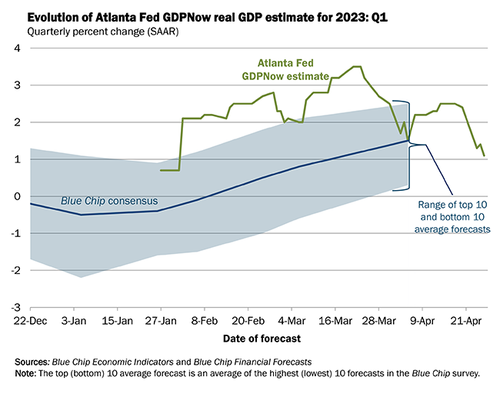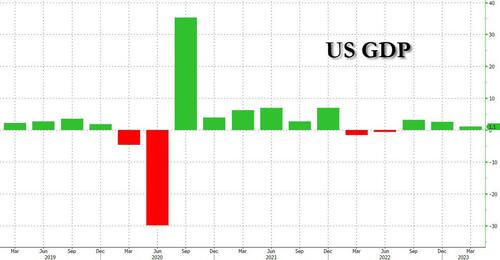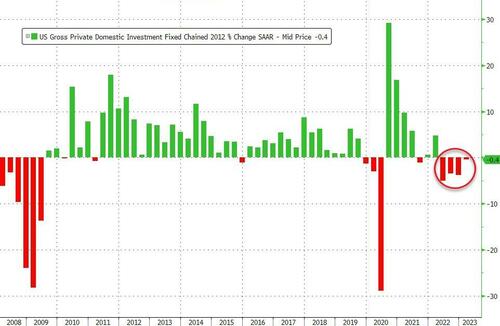See other National News Articles
Title: Stagflation: Q1 GDP Much Weaker Than Expected On Inventory Plunge As Inflation Comes In Red Hot
Source:
[None]
URL Source: https://www.zerohedge.com/markets/s ... plunge-inflation-comes-red-hot
Published: Apr 27, 2023
Author: Tyler Durden
Post Date: 2023-04-27 10:15:13 by Horse
Keywords: None
Views: 14
With the Atlanta Fed showing a clear slowdown in US GDP in recent weeks, revealing estimates of US growth sliding from over 3% in late March to just 1.1% yesterday... ... the trend is clear: the US economy is rapidly slowing down, in large part due to the "depressurization event" among small and medium regional banks, that has seen loan issuance grind to a halt. As such, today's first estimate of Q1 GDP would be interesting if very much dated. And so, with most banks expecting a print just around 2.0% - the median forecast was at 1.9% as shown below... 2.6% - JP Morgan Chase 2.3% - Citigroup 2.2% - Societe Generale 2.2% - HSBC 2.0% - Bank of America 1.9% - Credit Suisse 1.8% - Morgan Stanley 1.5% - Goldman Sachs 1.5% - UBS 1.0% - Barclays 0.8% - Wells Fargo ... there was an almost palpable gasp of surprise at 830am ET when the BEA reported that in Q1, real GDP rose just 1.1% (1.070% to be precise and smack right on top of what the Atlanta Fed said it would be), and a big drop from the 2.6% GDP in Q4. It was also the lowest GDP print since Q2 2022 when growth was negative to the tune of -0.6%... . and was more than a one-sigma drop from the median estimate of 1.9%. The deceleration primarily reflected a downturn in inventory investment and a slowdown in business investment (more details below). These movements were partly offset by an acceleration in consumer spending, a smaller decrease in housing investment, and an upturn in exports. Imports also turned up. Looking at the components we find that while Personal spending came in just a tad weaker than expected at 3.7% annualized vs exp. 4.0% (and up sharply from 1.0%) last quarter, it was the plunge in private inventories that hammered the GDP print - as we warned it would last quarter. Specifically, in Q1, private inventories subtracted a whopping 2.3% from the bottom line GDP print of 1.1% (after contributing 1.5% last quarter). Here is the full breakdown: Personal Consumption added 2.48% to the actual GDP print, up from 0.70% in Q4. Fixed Investment subtracted -0.07%, and after a -0.68% drop in Q4, Q1 was the 4th consecutive decline in fixed investment as the US has rolled out a full-blown capex boycott. A modest silver lining: residential investment was a drag on GDP for the eighth straight quarter -- but less of one. That category trimmed 0.17 percentage point off the annualized growth rate. That’s the least in a year. We’ve seen some signs of a bottoming in the housing market lately, as noted earlier, and this reflects that. The big hit, however, was the change in private inventories, which subtracted 2.26% from the GDP print, the biggest hit to the bottom line number since the covid crash. But while growth came in well below expectations, what the market was really freaked out about was the unexpectedly hot PCE and core PCE prints, the former coming in at 4.0% above the 3.7% expected and higher than the 3.9% in Q4, while core PCE came in at 4.9%, well above the 4.4% in Q4 and also hotter than the 4.7% expected. In fact, as shown below, this was the 5th consecutive "beat" of median core PCE expectations. Some more details from the report: Gross domestic purchases prices - the prices of goods and services purchased by U.S. residents - increased 3.8% in the first quarter after increasing 3.6 percent in the fourth quarter. Excluding food and energy, prices increased 4.3 percent after increasing 4.1%. Personal consumption expenditure (PCE) prices increased 4.2% in the first quarter after increasing 3.7% in the fourth quarter. Excluding food and energy, the PCE “core” price index increased 4.9% after increasing 4.4%. Bloomberg Intelligence Chief US Interest Rate Strategist Ira Jersey says the higher-than-expected inflation numbers from the first-quarter GDP report suggest the March PCE Deflator due out tomorrow might top expectations that were in place before today’s report. “The Treasury market is focused on the inflation data, and the bear steepening of the knee-jerk reaction seems appropriate to us. But tomorrow’s data will likely seal the Fed hiking 25 bps at next week’s meeting and leave another move in June on the table -- though with caution given the weaker-than-expected consumption in today’s data release.” Chris Zaccarelli, chief investment officer at Independent Advisor Alliance, had a far more downbeat view. He said that “this morning’s data was the worst of both worlds, with growth down and inflation up... Given that Core PCE is nowhere near the Fed’s 2% target (e.g. rising to 4.9% from 4.4%), the Fed clearly needs to keep raising rates (because of inflation) and they are going to be raising rates right into a slowdown. We are beginning to worry that stagflation is a real possibility.” 


Post Comment Private Reply Ignore Thread